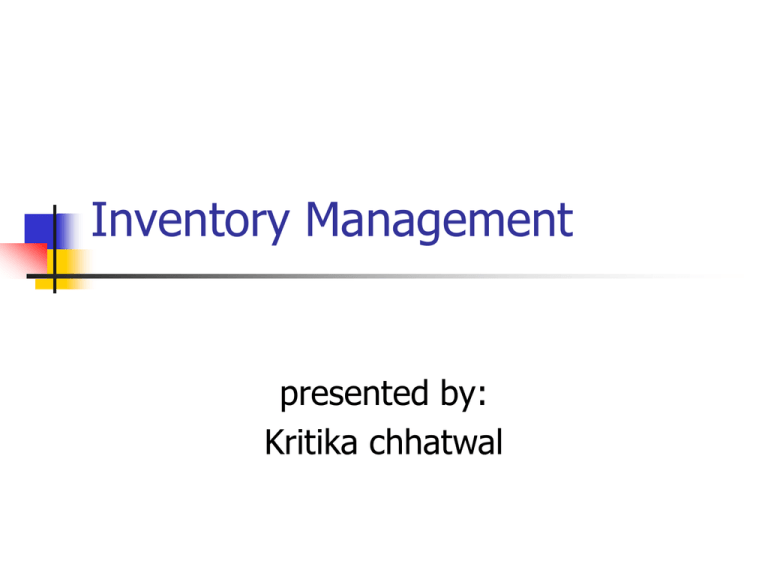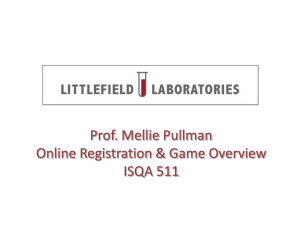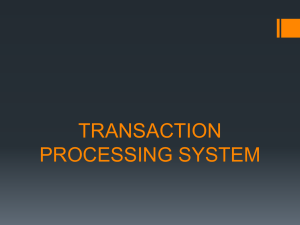Inventory Management I
advertisement

Inventory Management presented by: Kritika chhatwal Definitions Inventory-A physical resource that a firm holds in stock with the intent of selling it or transforming it into a more valuable state. Inventory System- A set of policies and controls that monitors levels of inventory and determines what levels should be maintained, when stock should be replenished, and how large orders should be Inventory Def. - A physical resource that a firm holds in stock with the intent of selling it or transforming it into a more valuable state. Raw Materials Works-in-Process Finished Goods Maintenance, Repair and Operating (MRO) Inventory Positions in the Supply Chain Raw Materials Works in Process Finished Goods Finished Goods in Field Nature of Inventory Quality - inventory can be a “buffer” against poor quality; conversely, low inventory levels may force high quality Speed - location of inventory has gigantic effect on speed Flexibility - location, level of anticipatory inventory both have effects Cost - direct: purchasing, delivery, manufacturing indirect: holding, stockout. HR systems may promote this-3 year postings Objectives To maintain a large size of inventories of raw material and work in progress for efficient and smooth production & of finished goods for uninterrupted sales. To maintain a minimum investment in inventories to maximize profitability. Need To Hold Inventory: Transacation Motive Precautionary Motive Speculative Motive Zero Inventory? Reducing amounts of raw materials and purchased parts and subassemblies by having suppliers deliver them directly. Reducing the amount of works-in process by using just-in-time production. Reducing the amount of finished goods by shipping to markets as soon as possible. Reasons for Inventories Improve customer service Economies of purchasing Economies of production Transportation savings Hedge against future Unplanned shocks (labor strikes, natural disasters, surges in demand, etc.) To maintain independence of supply chain Inventory and Value Quality Speed Flexibility Cost Design of Inventory Mgmt. Systems: 1)ECONOMIC ORDER QUALITY (EOQ) EOQ minimizes the sum of holding and setup costs. It involves two types of costs: a)Ordering costs b)Carrying costs 2)REORDER POINT The reorder point is that inventory level at which an order should be placed to replenish the inventory.To determine the recorder point under certainity we should know: a)Lead time b)Average usage Carrying costs Requisitioning Order placing Transportation Receiving ,inspecting ,storing Clerical & staff Ordering costs Warehousing Handling Insurance Deterioration Clerical & staff Some of Inventory Costs Procurement costs Out-of-stock costs Procurement Costs Order processing Shipping Handling Purchasing manufacturing Out-of-Stock Costs Lost sales cost Back-order cost Inventory control systems: ABC system JIT system Out sourcing system Computerised system Response based system ABC inventory control systems A Items: very tight control, complete and accurate records, frequent review B Items: less tightly controlled, good records, regular review C Items: simplest controls possible, minimal records, large inventories, periodic review and reorder JIT (just in time) inventory control system In JIT system eliminates the necessity of carrying large inventories, & thus saves carrying & other related costs. This system requires perfect understanding & coordination b/w the manufactures and suppliers. The JIT system complements the TQM. OUTSOURCING inventory control system It is a system of buying parts and components from the outsides rather than manufacturing them internally. For eg. Tata motors COMPUTERISED inventory control system It enables a company to easily track large items of inventories. It is an automatic system of counting inventories, recording withdrawals and revising the balance. The information of the buyers and sellers are linked to each other. RESPONSED BASED inventory control System Replenishment, production, or purchases of stock are made only when it has been signaled that there is a need for product downstream requires shorter order cycle time, often more frequent, lower volume orders determine stock requirements to meet only most immediate planning period (usually about 3 weeks) Objectives of Inventory Control system 1) Maximize the level of customer service by avoiding under stocking. 2) Promote efficiency in production and purchasing by minimizing the cost of providing an adequate level of customer service. Anticipatory Inventory Control determine requirements by forecasting demand for the next production run or purchase establish current on-hand quantities add appropriate safety stock based on desired stock availability levels and uncertainty demand levels determine how much new production or purchase needed (total needed - on-hand) THANKYOU









